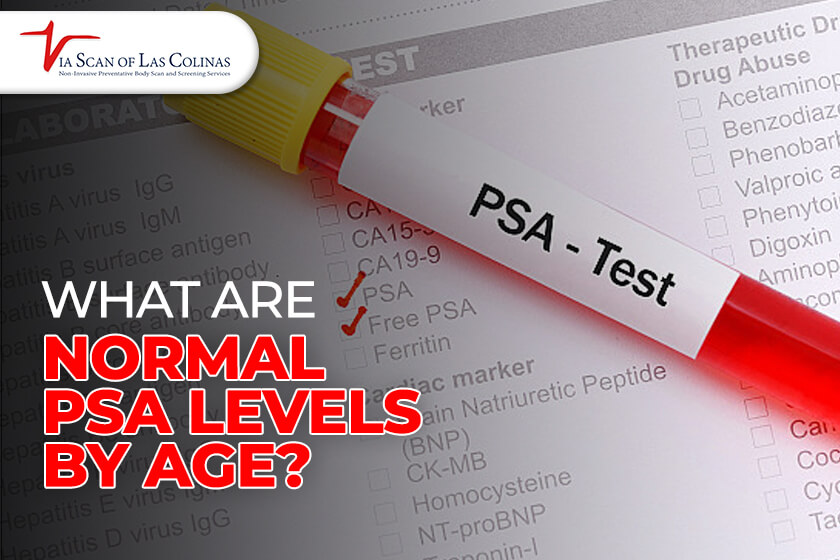One of the most popular tests for men’s prostate health concerns is the PSA (prostate-specific antigen) test. However, based on age, what is considered an average or elevated PSA can change significantly. Comprehending average PSA levels by age is critical for evaluating your test findings. While some PSA is acceptable, excessive levels might be a sign of prostate cancer or other issues like inflammation or enlargement. However, as men age, their PSA levels typically rise and vary. Therefore, the predicted levels at age 70 may differ dramatically from the normal PSA range at an earlier age.
The post analyzes PSA values according to age groups, paying particular attention to published reference ranges. This post will look at typical PSA levels by age group and what makes a harmful PSA at various ages. We will examine when, based on age, doctors view PSA as worrying and perhaps suggestive of malignancy. To provide age-specific context, we will also address frequently asked topics, such as What is a normal PSA level for a 60-year-old? Men can interpret test results more accurately if they know common PSA values.
What is a Dangerous PSA Level?
There is no certain PSA value that indicates a person will definitely get cancer. But generally speaking:
- A PSA of less than 4.0 ng/mL is considered low risk and normal.
- A modestly high PSA of 4–10 ng/mL calls for monitoring.
- A PSA of more than 10 ng/mL is regarded as highly elevated and may indicate prostate cancer or other illnesses.
The more elevated the level above 10 ng/mL, the higher the cancer risk. However, as we’ll further detail below, the normal PSA range varies with age. When determining whether an increased PSA is hazardous, doctors also consider other indicators, such as PSA history and results from prostate exams.
What is Normal PSA by Age?
As men age, normal PSA ranges change. The general PSA levels by age chart are as follows:
| Age Range | PSA levels |
| Age 40 and under | The typical range for PSA is 0-2.5 ng/mL. 2.5–4 ng/mL is a somewhat higher level. It’s possible to conduct more testing. Considered above average at 4 ng/mL, it may warrant a biopsy if additional risk factors exist. |
| Age 40 to 50 | The ideal range is 0-2.5 ng/mL. While still typical, up to 4 ng/mL is in the higher range. More testing and maybe a biopsy are indicated above 4 ng/mL and 10 ng/mL. |
| Age 50 to 60 | Normal range is 0-3.5 ng/mL. Although somewhat increased, 3.5–4.5 ng/mL could still be normal. Anything over 4.5 ng/mL is abnormal and needs to be closely watched. |
| Age 60 to 70 | 4 ng/mL is considered normal. Although somewhat excessive, 4-6.5 ng/mL could be typical. It is thought to be higher than normal when it is greater than 6.5 ng/mL. |
| Ages above 70 | It usually reaches 5 ng/mL. A modestly increased level of 5–7 ng/mL could be typical. Over 7 ng/mL is regarded as abnormal. |
The Value of Wellness Body Scan Examination
Men are better equipped to understand test findings when they are aware of age-based PSA ranges. PSA is only one piece of data, though. Consult your physician about obtaining Wellness Body Scans from ViaScan in order to evaluate your general health. Their cutting-edge scanners examine artery plaque, liver function, prostate enlargement, and various other risk indicators using ultrasound and 3D imaging. This allows them to spot issues early when they are most treatable. Utilize ViaScan’s sophisticated wellness body scans and PSA testing to obtain the most comprehensive picture of your health.
What is a Dangerous PSA Level by Age?
When determining whether an increased result is problematic and might suggest cancer, doctors consider both age and the absolute PSA number:
| Age Range | Dangerous PASA Level |
| Age Under 50 | More than 4 ng/mL is considered abnormal and may warrant a biopsy if it exceeds 10 ng/mL and there are additional risk factors.
|
| Age 50 to 60 | More testing is necessary for values greater than 4.5 ng/mL. Biopsy deemed more than 10 ng/mL. |
| Age 60 to 70 | The normal range is exceeded by 6.5 ng/mL. Above 10 ng/mL, a biopsy may be performed. |
| Age above 70 | Anything over 7 ng/mL is regarded as high. Above 10 ng/mL, a biopsy is typically performed. |
These PSA values, while not precise thresholds, usually indicate when physicians will look into a case more, particularly if there has been a sudden increase over time or if there are physical complaints.
What is Normal PSA by Age 30?
A normal PSA range is 0-2.5 ng/mL. Although rather increased for this age range 2.5–4 ng/mL, this could still be typical. In cases when additional risk factors are present, a biopsy may be recommended if the value is higher than 4 ng/mL. It is unusual to get a PSA above 2.5 ng/mL at this age, and it calls for ongoing observation to determine whether it stays elevated or is an anomaly.
What is a Normal PSA Level for a 60-Year-Old?
For sixty-year-old men normal is 0–4 ng/mL. It may still fall within normal ranges despite being somewhat increased. Above the typical reference range is defined as 6.5 ng/mL. More testing will probably be suggested by doctors.
According to certain research, a 60-year-old man’s upper limit of normal could be as high as 7 ng/mL. However, when the level is more than 6.5 ng/mL, most specialists recommend assessment.
What is a Normal PSA for a 65 Years and Above Man?
Four ng/mL is considered normal. Moderately increased at 4-6.5 ng/mL, although maybe within range. Above 6.5 ng/mL, the level becomes abnormally high and causes worry. Retests will probably be ordered by doctors. Elevations above 10 ng/mL are extremely abnormal and warrant a biopsy. Men in their mid-60s may not have PSAs as high as 6.5 ng/mL, but levels are checked for sharp increases.
What is a Normal PSA Level for Men of 70 Year and above?
In the early seventies, for men:
- The typical range of PSA is thought to be up to 5 ng/mL.
- Although somewhat increased, 5–7 ng/mL may be typical for some people.
- Anything over 7 ng/mL is abnormal and may be cause for concern. Physicians will conduct additional research.
- Anything more than 10 ng/mL is extremely abnormal and needs to be biopsied.
Physicians pay particular attention to variables including prostate lumps on exam and quick rises in PSA compared to stable results.
My PSA is 56, should I worry?
A PSA reading of 56 ng/mL is quite high and cause for great concern. As per recognized medical criteria, a PSA reading of 10–20 ng/mL is deemed dangerously elevated and indicates a significant likelihood of prostate cancer. A PSA reading this high usually calls for prompt further testing, including imaging studies, wellness body scans, and a prostate biopsy, to confirm or conclusively rule out the existence of cancer, even if a single test should not be interpreted in isolation. This high PSA value would indicate that further diagnostic evaluations should be scheduled as soon as possible.
Does a PSA of 20 Mean Cancer?
A PSA reading of 20 ng/mL or higher is considered very suspicious and suggests that prostate cancer is highly likely to occur by over 90%. When PSA is elevated, doctors will schedule more testing right away, such as a CT scan, MRI, and tissue biopsy. A PSA greater than 20 ng/mL is regarded as extremely risky, and cancer needs to be ruled out.
Choose Our Preventive Wellness Body Scan
Early Detection Saves Lives!
-
- Accurate
- Quick Result
- Affordable

Conclusion
What constitutes a normal or high PSA level can vary significantly based on age. While PSA above 4.0 ng/mL is generally elevated, expected normal PSA ranges for men in their 40s differ from men in their 70s. Understanding published PSA levels by age helps provide context when interpreting test results. Be sure to discuss your PSA with your doctor relative to your age cohort. Combining PSA testing with imaging scans from ViaScan provides the most complete diagnostic assessment. Know your PSA baseline numbers and get a wellness body scan early for the healthiest outcomes.



